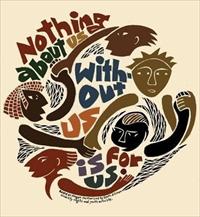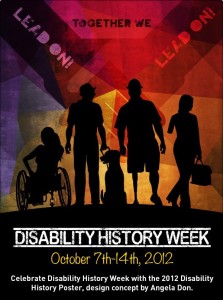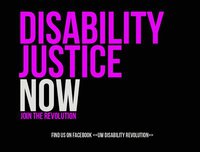Pity and the Blind Beggar
The video in this piece, The Power of Words, is a creation of PurpleFeather, a company that provides online marketing services, copywriting, videos, and digital images. The video appears on Purplefeather’s website as as a putative example of its high-quality professional work, and the content is intended to advertise its copywriting services.
I’m tempted to call this video inspiration porn, but it doesn’t quite fit the bill. For one thing, the image of the disabled person is not intended to inspire able-bodied people to rise to great heights of achievement through diligence and a winning attitude. For another, the piece is not intended to get able-bodied people to quit complaining about the problems in their lives. In fact, the disabled person in the video is not meant to inspire, but to provoke pity. This pity works to elicit largesse in a passerby, who uses words in such a way that people will feel moved to open their wallets and do business with Purplefeather.
So it’s not inspiration porn. The term pity porn would come closer. The disabled person in the video is simply there as a pitiable prop, an opportunity for a well-to-do able-bodied character to provide a stunning example of the way that Purplefeather will harness the awesome power of language for you. Watch the video, and you’ll see what I mean.
Here’s how it works.
The piece opens with piano music in a minor key, and shows an older blind man, sitting alone on the street, begging for spare change. The scene then quickly cuts to groups of younger able-bodied people laughing and talking with one another: first a group of three, then a group of two, all women. A well-dressed woman walks by the man as though he is invisible. Another woman sits at an outdoor café smoking a cigarette and watching the world go by. Three more young women are smiling and talking.
The opening sequence establishes the blind man as alone and apart. He is the only male whose face is shown. He is the only older person in the piece. He is the only disabled person in camera range. He is the only one who is not well-dressed. Except for the woman walking by and ignoring him, and the woman smoking a cigarette, he is the only person who is not talking and laughing with someone else. So the impact of the visual rhetoric of the video is that the old man is completely isolated.
The next sequence visually establishes the man as being at the very bottom of the social hierarchy. He is sitting on the ground, while everyone else is standing and walking past him. Even those few philanthropic individuals who give him change don’t bother to stop and hand him the money. They just throw the change in his direction. The blind man tries to find the change, locates it, and puts it in the tin next to a sign that says, I’M BLIND PLEASE HELP. From his position at the bottom of the pecking order, that’s all he can do – beg for help. Then, another well-dressed guy chucks change at him. The blind man gestures to say thank you, but the man has ignored him and hurried off.
Finally, we see a well-dressed woman in sunglasses, followed by a shot of the blind man sitting at the bottom of the steps in a nearly abandoned plaza. This shot brings the message home: He is all alone at the very bottom of the social order, literally and figuratively.
It is his isolation and his abased social status that provide the opportunity for the message of the video. He is alone, he is ignored, and he is not having much luck getting even a few crumbs from the table of the well-to-do. But never fear! A noble humanitarian takes pity and comes through. At this moment, the visual rhetoric of the video fits squarely into the category of the sentimental as described by Rosemarie Garland-Thomson: “The sentimental produces the sympathetic victim or helpless sufferer needing protection or succor and invoking pity, inspiration, and frequent contributions.” (Garland-Thomson 2002, 63) The noble humanitarian in the video not only gives the blind man (unrequested) aid, but becomes the catalyst for increased “contributions” to his cause.
The woman in sunglasses from the previous sequence walks by, turns back, stops, and looks at his sign. Without asking his permission, inquiring about his needs, or you know, maybe just giving him some respect, she takes it upon her noble (and paternalistic) humanitarian self to write on the back of his sign.
I don’t know about you, but if I were sitting on the street with a sign, I would not take kindly to some stranger coming over, grabbing my sign, and deciding to write something on the back of it. I’ve got this thing about boundaries. And strangers.
But of course, in the logic of the video, a blind man has no boundaries because he can’t see what she’s doing anyway. And no one has to talk to him, because, you know, he’s disabled, and poor, and socially isolated. As Bill Peace points out in his excellent takedown of the video, the man has been reduced to complete helplessness, and all the power goes to the nondisabled woman: “This man is dehumanized in the extreme. The poor bastard cannot not even write a sign worthy of a beggar. This is left to an able bodied woman. You know, those all powerful people that can walk, hear, and see.” (Peace 2012)
And then something truly odd happens. The blind man touches the woman’s shoes, without her permission.
I find this strange — not the fact that he is using his hands to see, but the fact that he’s touching a woman’s feet without her permission. I don’t know, maybe everyone in the video is living in some parallel universe without the boundaries I take for granted, but it seems to me that people generally ask permission to touch the shoes of complete strangers. In any case, the fact that he touches her feet simply reinforces his debased social status, because he is so far to the bottom of the hierarchy that the woman does not come to his level so that he can touch her face.
So the woman puts the sign back and goes on her way. And then, woo-hoo! The guy hits the motherlode. Not only does he get a chunk of change, but people walk by and bend down to give it to him instead of just chucking it at him from five or six feet up. He’s got so much spare change that he can’t keep up with it. By the time it’s over, the guy must have made, like, about three dollar and fifty cents. WOW! Score!
In the midst of this windfall, the woman in sunglasses comes by again. The blind man touches her shoes. Again.
And then he speaks. Yes! HE SPEAKS. He has a voice. He asks:
What did you do to my sign?
She finally gets down to face him, but it’s not to treat him as an equal. Oh, no. It’s to patronize him. She says, in her most gentle, concerned, and kind humanitarian voice:
I wrote the same
and then adds, touching him on the shoulder to show her great concern (because don’t we all just LOVE that?),
But different words.
Wow. Deep.
The blind man nods as though he understands what she’s talking about – which is odd because, at this point, I have no idea what she’s talking about. And I find it even more odd that he doesn’t say, “Look, lady, what the hell did you write on my sign?” He simply reaches out and says thank you, while the woman walks off into the sunset, having discharged her kindly humanitarian duty for the day, and with a heartwarming story to tell the family over dinner. Oh, and without putting any money in his tin.
Once she strides off, we can finally see what she wrote:
IT’S A BEAUTIFUL DAY AND I CAN’T SEE IT.
Oh, yes. Of course she wrote that. Of course. Because obviously, as EVERYONE knows, there is nothing – and I mean NOTHING – worse in this world than to be blind on a beautiful day. I mean, if the very thought doesn’t bring tears to your eyes and make you want to do a good deed, I don’t know what would. You’d have to be made of ice not to throw a few pennies in the old guy’s cup, just to lift his poor suffering spirits before you go on your way and forget all about him five seconds later.
And the moral of the story? Get ready:
Change your words.
Change your world.
[cue stunned silence]
WHAT? What, what, what, what, WHAT? How has this guy’s world been changed? Does he have a job? A place to live? Food to eat? Respect? Accommodations? Opportunity? Safety? Inclusion? Justice? There is not even an attempt made to consider these questions. As Bill Peace points out, “No thought, none, is given to why people with a disability may be forced onto the street to beg.” (Peace 2012) How can the failure to ask these questions change the world one iota?
It can’t. But rest assured that most of the people who have seen the video are tearfully nodding in agreement — oh, yes, isn’t it beautiful what the power of words has done for this poor guy! And the world goes on, much as it had before.
References
Bad Cripple. “Purplefeather: Offensive in the Extreme.” http://badcripple.blogspot.com/2011/04/purple-feather-offensive-in-extreme.html. April 11, 2011. Accessed June 13, 2012.
Garland-Thomson, Rosemarie. “The Politics of Staring: Visual Rhetorics of Disability in Popular Photography.” In Disability Studies: Enabling the Humanities, edited by Sharon L. Snyder, Brenda Jo Brueggemann, and Rosemarie Garland-Thomson, 56-75. New York, NY: Modern Language Association of America, 2002.
Purplefeather. http://www.purplefeather.co.uk. Accessed June 13, 2012.
YouTube. “The Power of Words.” http://www.youtube.com/watch?v=Hzgzim5m7oU. February 23, 2010. Accessed June 13, 2012.
© 2012 by Rachel Cohen-Rottenberg









3 comments already | Leave your own comment
Bob Rottenberg
6/14/2012 | 10:26 am Permalink
Wow — I gotta admit that I tear up every time I see this amazing piece of marketing. And you’re so right about all this. After all, the ad is not aimed at blind people, or even at any disabled person — it’s aimed at the rest of us poor schleppers who feel sorry for ourselves every day of the week because G-d hasn’t yet delivered our new Mercedes Benz that we’ve been asking for. If only we could change our words, imagine how our world could change! Wow again. Forget about the blind guy begging for change. Forget about the guy in the wheelchair who can’t get up the stairs. Forget about the woman who gets overwhelmed by loud noises and has to leave the store or restaurant. They don’t matter (they’re just the disabled few). All we have to do is change our words and watch how the world around us changes! Amazing! Would that it would be that easy for anyone! And thanks!
Jennifer
6/15/2012 | 6:09 pm Permalink
Thank you, Rachel. This is fantastic. As I watched the ad, I was appalled at the woman’s disrespect and outraged at her sense of entitlement to deface someone else’s property without speaking a word to the man right in front of her. As the ad then further dehumanized the man, so that he was incapable of speaking, until he later could grovel in appreciation I was left disgusted and deeply upset. Your brilliant piece, however, restored my sense of hope for the world: There are people like you speaking up and showing the world how it is our culture that is disabling people. Thank you for your brilliant, witty and eloquent writing.
AS from Boston, MA, USA
6/28/2012 | 11:13 am Permalink
I have now “flagged” the video citing “hate” speech. But I doubt it will do any good — You Tube seems to define hate speech a bit narrowly for our purposes (it apparently has to be something that actively promotes violence).